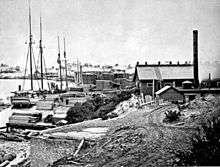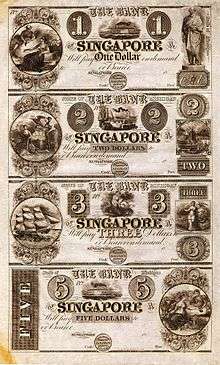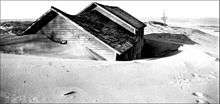Singapore, Michigan
Singapore is a ghost town in Michigan, United States. It was one of the casualties of the four great fires (Chicago, Holland, Peshtigo, and Manistee) that ravaged the northern Midwest on October 8, 1871.[1] Its ruins now lie buried beneath the sand dunes of the Lake Michigan shoreline at the mouth of the Kalamazoo River in Saugatuck Township, near the cities of Saugatuck and Douglas in Allegan County.


It was founded in 1836 by New York land speculator Oshea Wilder, who was hoping to build a port town to rival Chicago and Milwaukee.[2] At its height, the town boasted of three mills, two hotels, several general stores, a renowned bank, and was home to Michigan's first schoolhouse. In total, the town consisted of 23 buildings and two sawmills.[3]
The great bank scandal

In 1838, two banks were established in Allegan County: the Bank of Allegan and the Bank of Singapore. Both were "of the famous wildcat species".[4]
By 1838, over $50,000 in Singapore Bank notes had been placed in circulation. Shortly after the Civil War, Singapore was involved in a bank scandal. State banks were required to maintain enough hard currency on hand to cover at least 1/3 of the banknotes that were circulating, and neither Singapore nor Allegan was at that level.
From time to time collectors come across Singapore banknotes used by the Singapore Bank. There are a few known full sheets of the banknotes before they were cut into individual notes, sometimes signed and sometimes unsigned by the bank president or authorized personnel at the time.[5]
40-day blizzard
The 40-Day Blizzard of 1841 might very well have wiped out the people of Singapore, had it not been for the shipwreck of the Milwaukie just off her shore. The food with which that ship was stocked nourished the people of Singapore until the blizzard blew over.[6]
Change of ownership
Wilder deserted the town in 1846, moving back to Calhoun County. James Carter of New York bought out Wilder's interest in the town and moved there to oversee his investment. It was only two years after that that Carter sold the town to his brother, Artemas. Artemas was more innovative than his brother, and very soon after arriving, built a three-masted schooner, dubbed the Octavia, to carry lumber from Singapore to Chicago over Lake Michigan. The town thrived and boasted a population of several hundred people by 1871.
Singapore's demise

After the fires which swept through Chicago, Holland, and Peshtigo in late 1871, Singapore was almost completely deforested supplying the three towns with lumber for rebuilding. Without the protective tree cover, the winds and sands coming off Lake Michigan quickly eroded the town into ruins and within four years had completely covered it over.[7] The town was vacated by 1875.
Today, Singapore lives on only in the name of the Singapore Yacht Club, which is at one end of town. Just as the "cow kicking over the lantern" story was born out of the Great Chicago Fire, this event also gave birth to a legend. The story persists that one resident of Singapore refused to move, even as the sand enveloped his home. Eventually, he had to enter and leave the dwelling by a second-floor window, and he stayed until the sand reached the roof.[7]
References
- "The Great Fire of 1871". History of Manistee County, Michigan. H.R. Page & Co. 1882. Retrieved March 25, 2010.
- Brennan, James (2009). "Singapore, Michigan". Michigan Historical Markers. Retrieved March 25, 2010.
- "Singapore". Ghost Towns. Retrieved March 25, 2010.
- Pioneer Society of the State of Michigan (1881). Report of the Pioneer Society. Vol. III. W. S. George & Co. p. 273 – via Google Books.
- "Singapore Michigan Obsolete Bank Notes: The Story".
- "Michigan Tours". Pure Michigan. Archived from the original on March 20, 2007. Retrieved March 25, 2010.
- Royce, Julie Albrecht (2007). Traveling Michigan's Sunset Coast. Dog Ear Publishing. pp. 58–59 – via Google Books.
Further reading
- Starring, Charles R. (1953). Singapore: Michigan's Imaginary Pompeii.
- Schmiechen, James (2010). "Historic Significance of the Old Singapore Site Today". Saugatuck-Douglast Historical Society.
External links
| Wikimedia Commons has media related to Singapore, Michigan. |